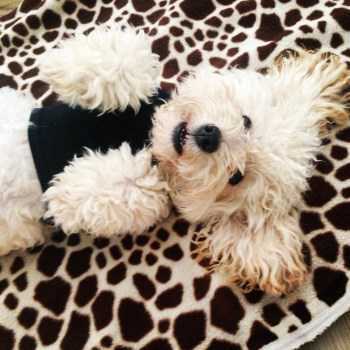Maltipoo Dental Care
Miss Peaches, at 1 year old, photo courtesy of Gionna & Julius Diez
Overview
Taking good care of your Maltipoo's teeth is one of the most important tasks you will have in regard to daily, regular care. This article will explain why this is so vital and take you through the easy steps to make sure your Maltipoo puppy or dog has excellent dental hygiene, which will affect them both now and for years to come. We will also cover some frequently asked questions regarding a Maltipoo's teeth.
Please note: PetMaltipoo is reader-supported. Some of the product suggestions on this page are affiliate links. As an Amazon Associate we earn from qualifying purchases. This is at no extra cost to you and helps us continue creating useful content.
Quick FAQ
At what age does a Maltipoo lose their puppy teeth?
Teething, which is the process of the deciduous teeth (puppy teeth) falling out and being replaced by the adult teeth, tends to happen between the 4 month mark and 12 month mark. It does not happen all at once. Usually the order is incisors, canines, and then molars.
What sort of care does a puppy need during the teething process?
There may be lots of chewing urges during the teething phase that may require specific teething toys and other methods to help ease itching and discomfort. This is also a good age to establish good dental hygiene (details ahead).
How may teeth do Maltipoos have?
All dogs, no matter the breed or size, have the same amount of teeth. So, Maltipoos, like other canines, have 28 deciduous teeth as a puppy and then 42 teeth as an adult (20 on the top and 22 on the bottom).
Are Maltipoos prone to dental/tooth issues?
Yes. Toy and small breeds tend to be prone to dental decay, infections, and other issues with the teeth in comparison to larger dogs. So, the Maltipoo, which is a hybrid of the Maltese and the toy (and sometimes miniature) Poodle is in this category. This means that keeping a Maltipoo's teeth and gums clean and healthy is an important part of proper care.
Is it normal for a Maltipoo to having missing teeth?
It is not uncommon for senior Maltipoo dogs (8 years and older) to have one or more missing teeth. This is not to say it is normal, however. It is often due to past dental neglect that led to teeth becoming so decayed that they eventually fell out.
What are some signs of dental neglect?
Some signs that a Maltipoo has an issue (which can range from plaque buildup to decay to infection) include:
- Foul-smelling breath
- Visibly yellow teeth
- Swollen gums
- Trouble chewing
- Cracked or loose teeth
If you notice any of these issues, it's imperative to have the veterinarian assess your Maltipoo's teeth. Once professional treatment has been given, you may be able to continue treatment at home, including at-home cleaning (details ahead) to help prevent future issues.
Why Regular Dental Care is Important
There are a lot of issues that can develop if a Maltipoo's teeth are not properly taken care of. It all starts with dental plaque, Plaque forms when bacteria in the mouth mix with starches from food. It is a clear and sticky substance that strongly clings to the teeth. If not scrubbed away, it turns into tartar which is a hardened version that is even more difficult to remove.
Both plaque and tartar do a lot of damage, eating away at a dog's tooth enamel. They also spread down under the gum line, doing additional damage sight unseen.
The continual attack of plaque and tartar leads to tooth decay, gingivitis (gum disease), periodontal disease (infection that affects both the gums and jaw bone), degradation of the jaw and surrounding bone, infection (localized to teeth or spreading to sinuses or bloodstream [sepsis]), and eventual tooth loss which can be painful and severely affect a dog's ability to eat enough.
So, as you can see, there are many reasons for ensuring your Maltipoo's teeth are properly cleaned.
How to Clean a Maltipoo's Teeth
There are several good options for taking good care of the teeth and gums, so if your Maltipoo does not like or tolerate one method, there are alternatives. In most cases, two or more methods done in conjunction will be effective enough to keep plaque at bay.
#1 Daily brushing. Just like with us humans, this is by far the most effective method of effectively clearing away plaque off a dog's teeth and keeping the gums healthy. The key to this is to do it thoroughly and consistently, using a proper canine toothbrush (either a manual handle brush) or a finger brush (a small doodad that slips over your index finger) along with a quality canine toothpaste.
In regard to products, i's important to note that human toothpaste should never be used, as it often contains fluoride (toxic to dogs) which will be swallowed and foaming agents which can cause a dog to choke. Canine toothpaste, on the other hand, is meant to be ingested, does not contain fluoride, and does not have dangerous soaping or foaming ingredients. The Nylabone Advanced Oral Care Dental Kit is a small kit that contains both types of brushes and a quality toothpaste; note that for most small Maltipoo, the 'puppy' size is also appropriate for adults.
The age to start brushing a dog's teeth is as early as 8 weeks old; though the deciduous teeth will fall out and be replaced by adult teeth, early dental care allows a pup to become accustomed to the feel of the brush and taste of the paste. This said, there is no age that is too late to start.
If you have an older dog, whose previous dental care was lacking, it's best to first have the veterinarian evaluate their teeth (and possibly perform a professional cleaning, which involves scraping the teeth).
How to brush a the teeth is fairly straightforward. Though you'll want to use a method that keeps your Maltipoo at ease, it can be helpful to sit on the floor with your little guy or gal between your legs and facing away from you. You can use your legs to gently hold them in place. Use your dominant hand to brush and your other hand to assist by firmly yet gently holding their chin. Be sure to praise your Maltipoo afterwards; reward with a training treat can also be helpful.
In regard to how long to brush, it's recommended to start with short sessions (just a minute or so) with a finger brush and then gradually work up to 5 minutes (with either type of brush). This should be done daily.
#2 Daily spray. With many dogs, a spray may not fully take the place of brushings, however it can have it's place in keeping a Maltipoo's teeth clean and healthy. For dogs that simply cannot learn to tolerate a toothbrush, certain dental sprays can be helpful when used alongside another method (such as quality dental chews).
Note that not all sprays are alike. Some are designed only to cure bad breath (halitosis) with dogs. Although halitosis is a sign of plaque buildup and other dental issues, treatment for it is often inadequate for cleaning. For this, a spray specifically designed to decrease the production of plaque is recommended. One that we like is Pets Are Kids Too Pet Dental Spray.
#3 Dental chews. These are edible treats designed to help scrape plaque off a dog's teeth via it's very hard consistency and its shape. Offering a daily chew alongside brushing or sprayings will be much more effective than chews alone. This said, they can be quite effective when given consistently (one per day).
The general idea of doggie dental treats is that the teeth are naturally scraped while a dog is chewing on the hard surface. Therefore, dogs should be supervised when chewing on these. Small pieces may break off, which should be promptly picked up and tossed in the trash.
One of the most popular dental treats is Greenies Natural Dog Dental Chews. These can be found in a variety of sizes ('Teenie' is for dogs 5 to 15 lbs.) and flavors including blueberry and grain-free.
#4 Dental wipes. It's important to note that dental wipes for dogs typically do not remove hardened tartar (the substance that appears yellow on the teeth). Rather, these are meant as a preventative method to stop future buildup. So, if your Maltipoo has tartar, it will first need to be removed (most often via a professional scraping by the veterinarian). Then, starting with a 'clean slate' brushing, spray, or wipes can be used alongside dental chews.
Also note that there are many types of wipes that use a wide variety of ingredients. Steer clear of those that contain artificial coloring dyes (found even on white wipes) which can cause allergic reaction and/or are linked to a wide range of health issues. Also look for a 'made in the USA' label, such as John Paul Tooth and Gum Pet Wipes.
Professional 'Full Dental' Cleanings at the Vet's Office
In some cases, a professional examination and cleaning will be needed. This is to diagnose dental issues and perform an in depth cleaning that simply cannot be done at home. This sort of procedure is often seen with rescues that have a history of neglect and other dogs that lacked proper dental care for a year or more. Certain dogs that are particularly prone to tartar buildup, regardless of at-home care, may also require this sort of care.
Exams and cleanings in the vet's office are performed using sedation. One way to help make sedation safer for small dogs is to ensure a warming blanket is used while a dog is under anesthesia, so this is one aspect to discuss with the veterinarian.
With most dogs undergoing a 'full dental', the following will be done:
- X-rays are taken to assess teeth and bones of the mouth
- A prone is used to assess the gums
- Teeth are cleaned, including under the gum line, typically using ultrasonic scalers
- Teeth are polished
- A plaque-guard agent may be applied
Further treatment will be done for those with decay, infection, cracked teeth or other issues.
Other Articles You May Like:
Maltipoo Feeding Guidelines - A great overview of all dietary requirements. Includes feeding schedules, wet vs dry, grain vs grain-free, and other aspects. For puppies, adults, and seniors.
How to Keep a Maltipoo Clean - Many Maltipoos have light hair, so keeping the coat clean can be a challenge. See our top tips for keeping your little guy or gal looking nice and tidy.
How to Cure Maltipoo Boredom - If you're looking for some ways to bring more fun into your Maltipoo's life, we have some fantastic ideas! See 6 ways to keep a Maltipoo busy via teamwork activities and 6 ways via independent play.


